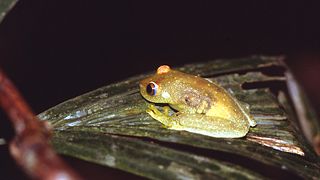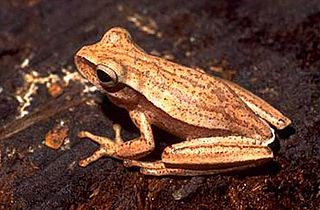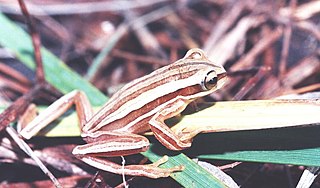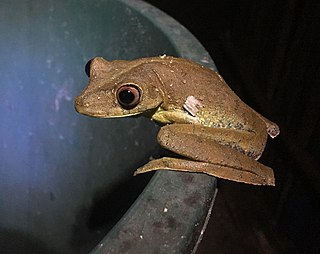
The white-spotted tree frog is a species of frog in the family Hylidae found in Argentina, Bolivia, Brazil, Paraguay, and Uruguay. Its natural habitats are moist savanna, subtropical or tropical moist shrubland, subtropical or tropical high-altitude shrubland, intermittent rivers, intermittent freshwater lakes, freshwater marshes, intermittent freshwater marshes, and urban areas.
The Cagua tree frog is a species of frog in the family Hylidae endemic to Venezuela. Its natural habitats are subtropical or tropical moist lowland forests, rivers, freshwater marshes, and intermittent freshwater marshes. It is threatened by habitat loss.

The Yungas tree frog is a species of frog in the family Hylidae found in Bolivia and Peru. Its natural habitats are subtropical or tropical moist lowland forests, subtropical or tropical moist montane forests, rivers, and canals and ditches.

Bischoff's tree frog is a species of frog in the family Hylidae endemic to Brazil. Its natural habitats are subtropical or tropical moist lowland forests, rivers, freshwater lakes, freshwater marshes, and plantations. It is threatened by habitat loss.

The striped tree frog is a species of frog in the family Hylidae found in Argentina, Brazil, and Paraguay. Its natural habitats are subtropical or tropical dry forests, subtropical or tropical moist lowland forests, subtropical or tropical dry lowland grassland, subtropical or tropical seasonally wet or flooded lowland grassland, rivers, swamps, heavily degraded former forests, and ponds. It is not considered threatened by the IUCN.

The Charuplaya tree frog is a species of frog in the family Hylidae endemic to Bolivia. Its natural habitats are subtropical or tropical moist montane forests, rivers, and canals and ditches.

The Demerara Falls tree frog is a species of frog in the family Hylidae found in Bolivia, Brazil, Colombia, Ecuador, French Guiana, Guyana, Peru, Suriname, and Venezuela. Its natural habitats are subtropical or tropical moist lowland forests, subtropical or tropical swamps, rivers, freshwater marshes, intermittent freshwater marshes, rural gardens, and heavily degraded former forests.
The Campo Grande tree frog is a species of frog in the family Hylidae endemic to Brazil. Its natural habitats are subtropical or tropical moist lowland forests and rivers. It is threatened by habitat loss.
Boana goiana is a species of frog in the family Hylidae that is endemic to Brazil. Its natural habitats are moist savanna, subtropical or tropical moist shrubland, subtropical or tropical high-altitude shrubland, and rivers. It is threatened by habitat loss, though is still currently of least concern as its conservation status.

Boana guentheri is a species of frog in the family Hylidae that is endemic to Brazil. Its natural habitats are subtropical or tropical moist lowland forests, subtropical or tropical moist shrubland, freshwater marshes, intermittent freshwater marshes, arable land, pastureland, rural gardens, and seasonally flooded agricultural land.
Hutchins' tree frog is a species of frog in the family Hylidae found in Colombia and possibly Brazil and Peru. Its natural habitats are subtropical or tropical moist lowland forests and rivers. It is threatened by habitat loss.
Boana joaquini is a species of frog in the family Hylidae that is endemic to Brazil. Its natural habitats are subtropical or tropical seasonally wet or flooded lowland grassland, subtropical or tropical high-altitude grassland, rivers, and pastureland.
The Lema tree frog is a species of frog in the family Hylidae found in Guyana, Venezuela, and possibly Brazil. Its natural habitats are subtropical or tropical moist lowland forests, subtropical or tropical moist montane forests, rivers, pastureland, rural gardens, heavily degraded former forests, aquaculture ponds, and canals and ditches. It is threatened by habitat loss.

The Usina tree frog is a species of frog in the family Hylidae endemic to Brazil. Its natural habitats are subtropical or tropical moist lowland forests, subtropical or tropical moist montane forests, moist savanna, rivers, and plantations.
The Salta tree frog is a species of frog in the family Hylidae found in Argentina and Bolivia. Its natural habitats are subtropical or tropical dry forests, subtropical or tropical moist lowland forests, subtropical or tropical moist montane forests, rivers, freshwater marshes, and intermittent freshwater marshes. It is threatened by habitat loss.
Boana phaeopleura is a species of frog in the family Hylidae that is endemic to Brazil. Its natural habitats are subtropical or tropical dry forests, moist savanna, subtropical or tropical moist shrubland, subtropical or tropical high-altitude shrubland, and rivers. It is threatened by habitat loss.

Cope's eastern Paraguay tree frog is a species of frog in the family Hylidae endemic to Brazil. Its natural habitats are subtropical or tropical moist lowland forests, subtropical or tropical moist montane forests, rivers, intermittent rivers, freshwater marshes, intermittent freshwater marshes, arable land, pastureland, plantations, rural gardens, urban areas, heavily degraded former forests, ponds, irrigated land, and canals and ditches.
The Valle tree frog is a species of frog in the family Hylidae found in Colombia and possibly Ecuador. Its natural habitats are subtropical or tropical moist lowland forests, freshwater marshes, and intermittent freshwater marshes. It is threatened by habitat loss.
The La Escalera tree frog is a species of frog in the family Hylidae found in Guyana, Venezuela, and possibly Brazil. Its natural habitats are subtropical or tropical moist lowland forests, subtropical or tropical moist montane forests, rivers, and freshwater marshes.

The Upper Orinoco tree frog is a species of frog in the family Hylidae found in Brazil, Colombia, and Venezuela, and possibly Bolivia and Guyana. Its natural habitats are subtropical or tropical moist lowland forests, subtropical or tropical swamps, moist savanna, and rivers. It is threatened by habitat loss.











